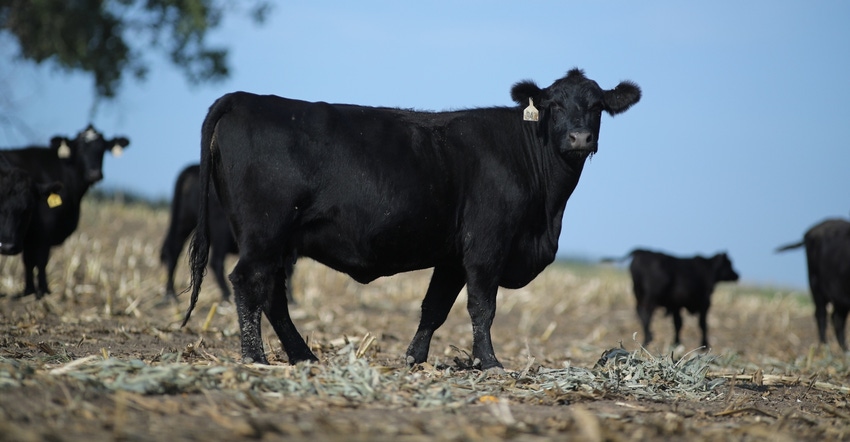More, older calves at weaning and a heavier, more uniform calf crop to sell: These are a couple of the benefits of using estrus synchronization in your herd.
September 1, 2022

Sponsored Content
As a beef producer, your goal is likely just that: Produce pounds of beef. And while breeding your herd using a tool like estrus synchronization isn’t for everyone, taking advantage of its benefits may be easier than you think.
Estrus synchronization involves administering a combination of different drugs to alter the females’ estrus cycles so they can be bred at about the same time.
“Estrus synchronization can provide tremendous benefits to the bottom line for many beef producers, particularly commercial operations,” said Dan Cummings, DVM, Boehringer Ingelheim. “First and foremost, it can help get more cows bred earlier in the calving season. The result is older, bigger calves at weaning and a more uniform, consistent calf crop. Uniform groups are not only easier to feed and manage, but they’re also more attractive to buyers.”
Some studies have shown as much as a 10- to 17-day calf age advantage and 20 to 44 more pounds per calf at weaning in programs using estrus synchronization.1
More pounds, less labor
In addition to producing more pounds of beef from a more uniform calf crop, estrus synchronization can shorten the calving season, concentrating the time you need to watch them, and giving you more time for other projects in your operation. If you keep replacement heifers, they’ll also likely be more uniform, reach puberty at the same time, and be ready to breed when you want them bred.
“Inadequate facilities, time constraints and labor shortages are often the biggest deterrents beef producers see when considering synchronizing their beef herd,” explained Dr. Cummings. “Programs involving artificial insemination or embryo transfer offer greater genetic advancement for a herd, but they also can involve four or even five trips through the chute. The key is working with your veterinarian and choosing an approach that fits your operation.”
Natural service may be the choice for you
Estrus synchronization paired with your bull battery can deliver many benefits without the intense management and labor needed with artificial insemination (AI) or embryo transfer (ET) programs. Synchronization with natural service gives you a chance to get experience with the practice, and can be a first step to implementing a full estrus synchronization and AI program.
“A synchronization program using natural service can be as simple as administering one injection of prostaglandin to the cows. Bulls are turned out the day the prostaglandin is given or five days after the drug is administered,” Dr. Cummings said.
But getting more cows bred early in the breeding season requires more than estrus synchronization, whether you choose natural service or AI. Dr. Cummings outlines these steps on the road to success for all programs:
Keys to breeding success
Work with your local veterinarian. Besides being a resource for all your herd health needs, your veterinarian can help you structure your breeding program, including products, timing and protocols for estrus synchronization. In addition, buying and using reproductive hormones such as prostaglandin requires a veterinary client-patient relationship.
Assess facilities and equipment. For safety and ease of handling, it’s important to have a sturdy alley that cattle move through easily and quietly, along with a chute that restrains the cattle for administering injections. In AI and ET programs, a solid, well-functioning chute or breeding box is also very important to restrain the animals, as well as for the safety and convenience of the technician.
Ensure the animals are on a good plane of nutrition and cycling. Work to ensure cows are receiving adequate nutrition prior to and during the breeding season, including a proper mineral program. Cows should have a body condition score of 5; first-calf heifers 5.5 to 6, and yearling heifers 5 to 6. Adequate nutrition will ensure most of the herd is at least 40 days past calving at the start of breeding.
Administer all pre-breeding vaccinations. Just as you would prior to any breeding season, all pre-breeding vaccinations should be administered following label directions — usually 45 to 60 days prior to breeding.
Prepare bulls for the breeding season. Cows won’t conceive without service from a healthy, fertile bull. Be sure all bulls pass a complete breeding-soundness exam. Administer annual vaccines according to label directions well ahead of turnout. When combining estrus synchronization and natural service, use bulls that are 2 to 4 years old as well as agile, active and known breeders. A bull-to-female ratio of 1:15 to 1:25 is generally recommended. Be sure the bulls run together prior to turnout so their pecking order is set up, and they can concentrate on servicing cows rather than fighting.
Minimize animal stress. Heat, cold and rough or excessive handling are all stressors that can have a tremendously negative impact on any breeding program. Be sure to handle animals quietly and calmly. Minimize the impact of environmental stressors as much as possible, supplying water and shade in the summer and bedding and windbreaks in cold months.
Keep good records. Building on success and making improvements to any program are nearly impossible without detailed records from year to year. Be sure to keep track of protocols followed, products used and outcomes. Comparing individual calving dates and weaning weights from year to year can be useful in figuring out if your program is making progress or needs adjustments.
©2022 Boehringer Ingelheim Animal Health USA Inc., Duluth, GA. All Rights Reserved. US-BOV-0415-2022-A
1 Johnson S and Chenoweth P. Use of natural-service sires with synchronized estrus. K-State Research and Extension, Colby, KS. 2020. Available at: https://beefrepro.org/wp-content/uploads/2020/08/naturalservice.pdf Accessed June 30, 2022.
About the Author(s)
You May Also Like



